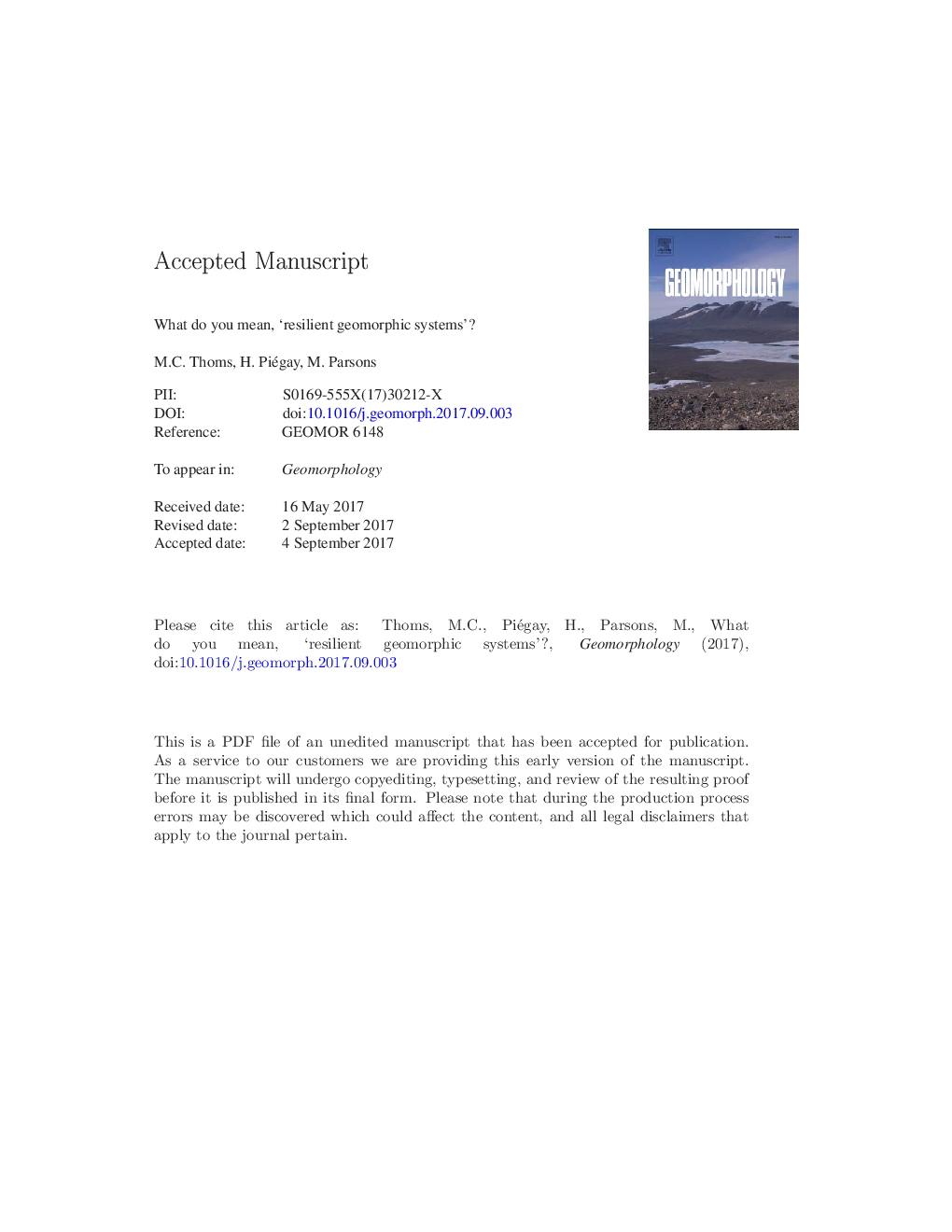| کد مقاله | کد نشریه | سال انتشار | مقاله انگلیسی | نسخه تمام متن |
|---|---|---|---|---|
| 8908150 | 1635345 | 2018 | 51 صفحه PDF | دانلود رایگان |
عنوان انگلیسی مقاله ISI
What do you mean, 'resilient geomorphic systems'?
ترجمه فارسی عنوان
منظور شما چیست؟ سیستم های ژئومورفیک انعطاف پذیر چیست؟
دانلود مقاله + سفارش ترجمه
دانلود مقاله ISI انگلیسی
رایگان برای ایرانیان
کلمات کلیدی
تفکر انعطاف پذیر، بین رشته ای، علم پس از عادی، چارچوب ها،
ترجمه چکیده
تفکر انعطاف پذیری در مطالعه ژئومورفولوژی همبستگی زیادی دارد. شباهت ها و تقاطع ها بین رشته ی علمی زمین شناسی و مفهوم انعطاف پذیری علمی وجود دارد. بسیاری از تم های اصلی اساسی ژئومورفولوژی به موضوعات اصلی انعطاف پذیری نزدیک هستند. استفاده از تفکر انعطاف پذیر در مطالعه سیستم های طبیعی و انسانی بر پایه فرض اساسی که اکوسیستم ها، اقتصادها و جوامع باید به عنوان سیستم های اجتماعی-محیطی مرتبط شود، گسترش یافته است. علیرغم ژئومورفولوژی و انعطاف پذیری، تمایل به تمایزات هسته ای، قدردانی از تاریخ و توسعه ژئومورفولوژی به عنوان زمینه تلاش های علمی توسط بسیاری از افراد در زمینه انعطاف پذیری محدود است، و همچنین آگاهی محدود از مبانی سابق در ظهور اخیر انعطاف پذیری این به طور بالقوه برنامه های کاربردی مفاهیم انعطاف پذیر را به مطالعه ژئومورفولوژی محدود می کند. در این دستنوشته، ما یک بررسی جمعی از ژئومورفولوژی و انعطاف پذیری را به عنوان وسیله ای برای مفهوم پیشبرد هر دو حوزه مطالعه ارائه می دهیم و همچنین اهمیت و اهمیت نه تنها درک پیچیدگی های سیستم های زمین شناسی در یک دنیای در حال ظهور چالش های بین رشته ای، همچنین اهمیت مشاهده کردن انسان به عنوان یک جزء ذاتی سیستم های ژئومورفیک به جای یک راننده خارجی است. استفاده از مفاهیم سلسله مراتب و مقیاس، اصول اساسی مطالعه سیستم های ژئومورفیک، وسیله ای برای غلبه بر رویکردهای محدود مقیاس معاصر در مطالعات انعطاف پذیری است. انعطاف پذیری چارچوبی برای ژئومورفولوژی فراهم می کند تا کاربرد آن را در دامنه وسیع تر اجتماعی-محیطی گسترش دهد.
موضوعات مرتبط
مهندسی و علوم پایه
علوم زمین و سیارات
فرآیندهای سطح زمین
چکیده انگلیسی
Resilience thinking has many parallels in the study of geomorphology. Similarities and intersections exist between the scientific discipline of geomorphology and the scientific concept of resilience. Many of the core themes fundamental to geomorphology are closely related to the key themes of resilience. Applications of resilience thinking in the study of natural and human systems have expanded, based on the fundamental premise that ecosystems, economies, and societies must be managed as linked social-ecological systems. Despite geomorphology and resilience sharing core themes, appreciation is limited of the history and development of geomorphology as a field of scientific endeavor by many in the field of resilience, as well as a limited awareness of the foundations of the former in the more recent emergence of resilience. This potentially limits applications of resilience concepts to the study of geomorphology. In this manuscript we provide a collective examination of geomorphology and resilience as a means to conceptually advance both areas of study, as well as to further cement the relevance and importance of not only understanding the complexities of geomorphic systems in an emerging world of interdisciplinary challenges but also the importance of viewing humans as an intrinsic component of geomorphic systems rather than just an external driver. The application of the concepts of hierarchy and scale, fundamental tenets of the study of geomorphic systems, provide a means to overcome contemporary scale-limited approaches within resilience studies. Resilience offers a framework for geomorphology to expand its application into the broader social-ecological domain.
ناشر
Database: Elsevier - ScienceDirect (ساینس دایرکت)
Journal: Geomorphology - Volume 305, 15 March 2018, Pages 8-19
Journal: Geomorphology - Volume 305, 15 March 2018, Pages 8-19
نویسندگان
M.C. Thoms, H. Piégay, M. Parsons,
